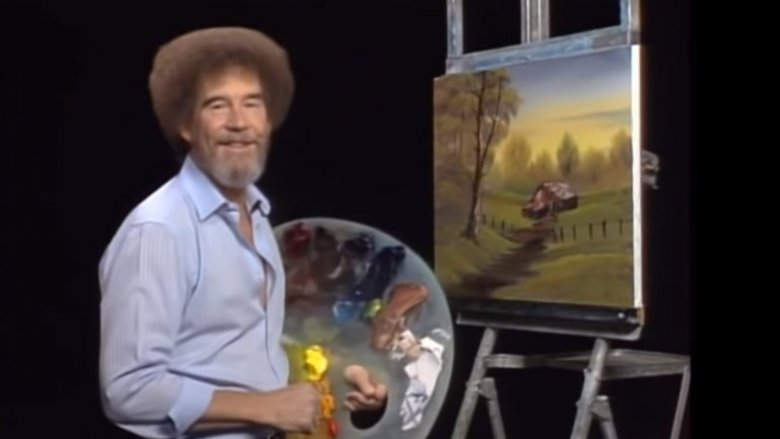Can You Buy A Bob Ross Painting? How Much Will It Cost?
Everyone loves Bob Ross, and if you don't love Bob Ross, it's clearly because you have an unhappy little soul. The truth hurts. Bob Ross was an icon back when he effortlessly created landscapes on PBS, and he's kind of even more of an icon now, about a quarter of a century after his 1995 death. So really, who wouldn't want to own one of Bob Ross' happy little paintings, except for those rare few individuals with unhappy little souls?
According to Smithsonian, Bob Ross made 1,143 paintings for his PBS show, The Joy of Painting. There were three versions of each individual painting. The first he made as a reference work to be used during the taping. (It was hidden off-camera, so Ross was actually copying the work, not spontaneously pulling it out of his permed head. You can take a moment to recover from that revelation if you need to.) The second painting in the trio was the one he made on camera, and the third he made afterward to be used in instructional books. But there were certainly more than that — Ross himself claimed he'd made 30,000 paintings in his lifetime, which is roughly 15 times as many as Vincent van Gogh is known to have made. So with that many Bob Ross paintings to choose from, it seems like you ought to be able to buy one, right?
Even Ross himself liked to give people hope: During one of his shows, he told viewers they might be able to buy an original painting during a PBS fundraiser. "One of the questions that I hear over and over and over is, 'What do we do with all these paintings we do on television?' Most of these paintings are donated to PBS stations across the country. They auction them off, and they make a happy buck with 'em. So if you'd like to have one, get in touch with your PBS station, 'cause ... we give them to stations all over the country to help them out with their fundraisers."
But alas, it seems to have been lies, all lies. Shame on you, Bob. Because if it was true that "most" of Ross' on-screen paintings were sold at auction to private collectors, you ought to be able to pretty easily track down one and buy it. But you can't. Not really. And it's not because they're coveted by collectors, hanging on the walls of people who just are not willing to part with them, or inside museums. According to the New York Times, it's actually because they're in a bunch of cardboard boxes in a room at Bob Ross Inc. Yes, much like the Ark of the Covenant, they're in storage, even if they belong in a museum. And Bob Ross Inc. doesn't plan on selling them, either.
Bob Ross Inc. currently has 1,165 original Bob Ross paintings in a private storage room in its northern Virginia headquarters. It's hard to say how many of those were created for the PBS show and how many of them were created for other reasons, but it's kind of starting to look like maybe "most" of them weren't auctioned off by PBS.
Some of Bob Ross' paintings were donated to the Smithsonian, though, so you could look at them ... but that's as close as you'll probably ever get. Although weirdly, the museum hasn't actually made any plans to put them on display yet as of this writing, so "when" is still a pretty big question.
If you're diligent and you keep your feelers out, though, an opportunity to buy a Bob Ross painting might one day surface. The president of Bob Ross Inc. told the New York Times that the paintings do occasionally sell online for between $8,000 and $10,000. And not long ago two of Bob Ross' earlier works showed up in an Alaskan antique store — before Ross taught the world the joy of painting, he used to paint gold pans and sell them for $25. In 2018, the pair of Ross original gold pans that arrived in the Alaskan antique store sold within a day for $3,500 each. If you do find an original Bob Ross listed for sale, though, here's a tip: Have it authenticated before shelling out that kind of money.
So you could, in theory, own a Bob Ross, but it won't be easy to find one and it won't be cheap, either. But hey, it's still way cheaper than a Van Gogh. For now.
